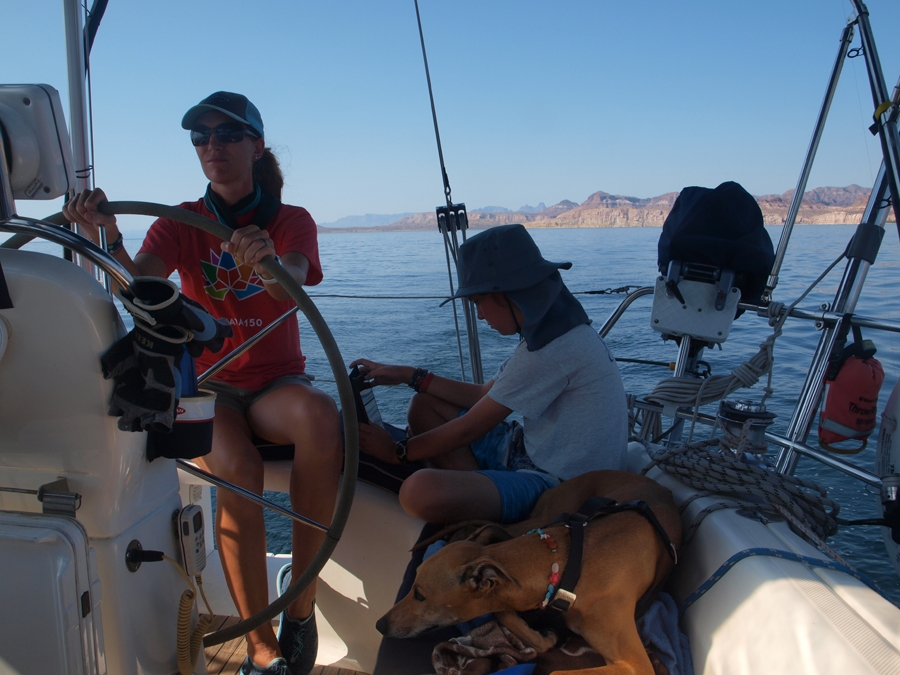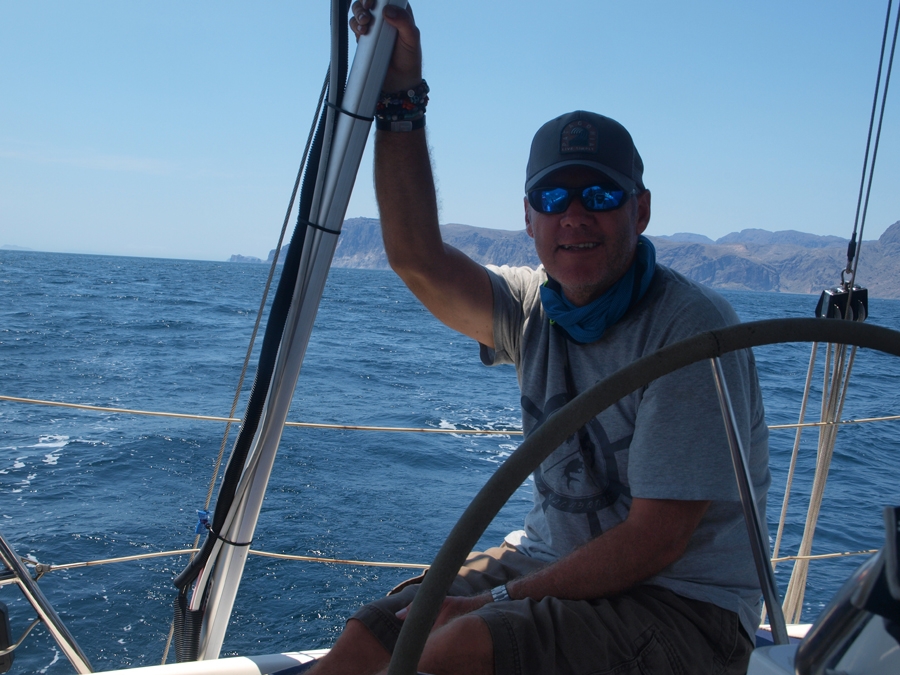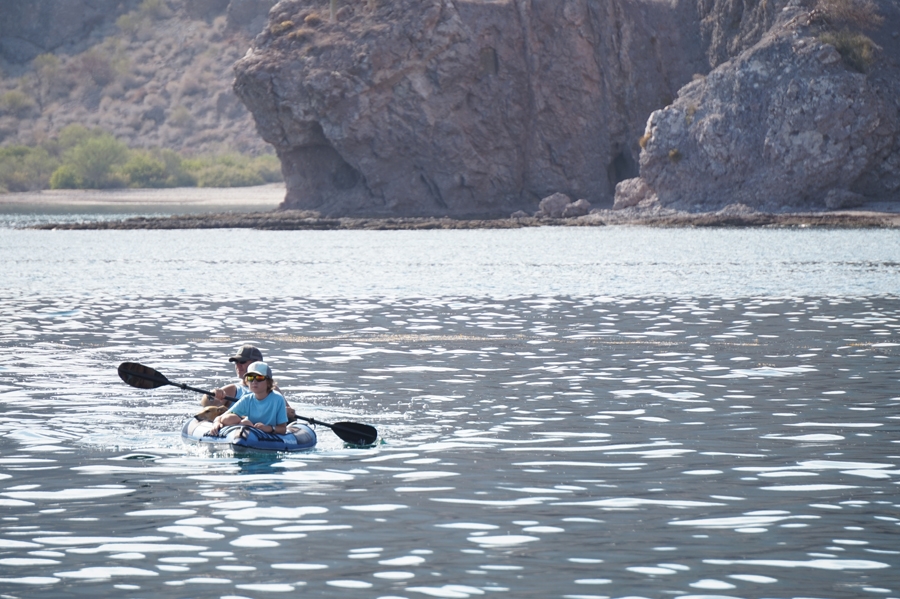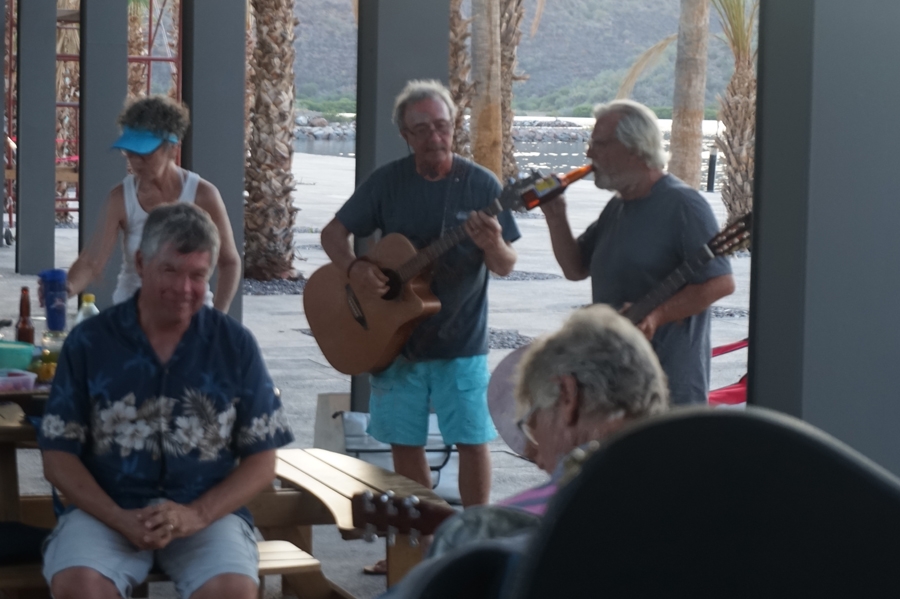We planned to leave La Paz in mid-June, but we had a couple of things come up that delayed us some. We discovered that our muffler had some corrosion in it which had created pinholes causing it to leak. No bueno. So, we either needed to order a new one from the USA (expensive and would take a while!) or try to repair the one we had. With the recommendation of the local mechanic in La Paz (Rob Cross from Cross Marine Works- originally from Victoria too!) we had our muffler sent to a fiberglass shop. They took a mold of the stainless end caps and were able to make exact replicas of them in fiberglass. This means no more corrosion! We had the center rubber tubing replaced as well and the muffler was ready to go. Other than the hose clamps holding it together, it was a completely new unit.
Ensenada Grande, Isla Espíritu Santo
We pulled out of Marina Costa Baja in La Paz on Sunday, June 25th and headed towards Ensenada Grande on Isa Espiritu Santo. With no wind and glassy seas, we motored the whole way, but were treated to the site of several jumping manta rays and several sea turtles as well. We pulled in to the anchorage to see several other boats including a few mega yachts (Ensenada Grande is a charter destination and so close to La Paz that it is popular for the party boats too!) We anchored underneath the white cross at 24° 33.49 N / 110° 23.87 W. This cove can get corumuels (strong localized nighttime winds) so be sure to set your anchor well. We only planned to stay one night here, so we opted not to inflate our dinghy or kayak, but go for a swim to shore instead since it was really close. We broke out the boogie board and Carson and Lisa swam in to shore, only to be greeted by several sting rays lurking in the shallows. Sting rays are hard to see, as they bury themselves in the sand, so you have to do the ‘sting ray shuffle’ with your feet as you walk to scare them away. Stepping on a sting ray is something that you want to avoid at all costs as it is one of the most painful stings and the venom travels up your leg! No thanks. Note that there is no Wifi or cell reception available in this bay or the majority of Isla Espiritu Santo.

Swimming at Ensenada Grande
Isla San Francisco
The next morning, we had breakfast and got going around 10am with our destination set at Isla San Francisco- one of the Sea of Cortez’s most famous bays. We were told by several other cruisers that during this time of year, it is ideal to anchor on the east side of the island and not in the famous ‘hook’ bay on the west side due to the wind picking up at night from the west, making it an uncomfortable overnight spot. The east side of the island was completely empty and we had the cove all to ourselves. We anchored at 24° 49.712 / 110° 34.579. We did some swimming to cool off and the boys kayaked in to shore to do some exploration. Unfortunately, right after dinner as the sun was starting to drop in the sky, the anchorage received a bunch of easterly swell and got extremely uncomfortable very quickly. We were forced out- luckily before dark and were able to make it around to the northern most anchorage on Isla San Francisco where it was much calmer, although still a bit rolly. One other mega yacht pulled in at the same time as us and dropped their anchor as well. There is no WiFi or cell reception available throughout all of Isla San Francisco.

Floating in the refreshing water at Isla San Francisco
San Evaristo
After one slightly-roily night at Isla San Francisco, we motored to San Evaristo. We were excited to visit this harbour as it is a little fishing village with a tienda, restaurant and supposedly, WiFi. We were sadly disappointed with this town was pretty much shut down when we visited. The only place that seemed to be open was Agua Tony’s water purification plant. There was a note at his entrance saying you could radio him on VHF channel 16, so we did. A lady was on and in broken Spanish, we tried to find out what the WiFi password was and when the tienda and restaurant would open. Her response was “No hay WiFi” (There is no WiFi) and “No se’” (I don’t know) So, the tienda was closed for our whole visit- as was the restaurant called Lupe’s. We were also told by the locals that sometimes if you stand in the middle of the soccer field there (while also being careful not to step in the numerous cow patties) you may be able to get cell reception. We were not able to, nor were we able to get cell reception with our booster. The winds also kicked up quite a bit at night in there, so be sure to set your anchor well. So, Evaristo was a bit of a bust for us…oh well!

Carson in front of Lupe’s Restaurant at San Evaristo
Punta San Telmo
We left San Evaristo around 9am on June 28th and were able to motor sail a bit until we got to Los Gatos- a popular anchorage amongst cruisers as it is famous for its gorgeous red rock cliffs. As we approached Los Gatos and looked into the bay, we soon realized why there were absolutely no boats anchored in there. the seas were kicking up big, choppy wind waves and there were big gusts going straight into the anchorage. No bueno. So, we resorted to our trusty Sea of Cortez guidebook by Heather and Shawn and opted for the northern anchorage around the point of Gatos, at Punta San Telmo. We were relieved to find another boat anchored in there when we approached , although disappointed to still see swell wrapping around and and making the anchorage a rolly one. With winds blowing around 15-20 knots when we approached, we anchored at 25° 19.912 / 110° 57.748. We were happy to discover that the other boat anchored nearby were our friends Hillary and Ty on sv Varuna. We follow them on YouTube and had linked up with them in Santa Barbara, San Diego and La Paz. It was great to catch up with them and nice to have some company in the anchorage. Punta San Telmo, (although rolly and windy when we were there) is a gorgeous anchorage. It still boasts the beauty of the red rock cliffs and provides decent protection from the south. During the night, we experienced an interesting phenomenon- rather than a corumuel, which affects the La Paz area mostly, we had a huge wind for several hours come pummeling down from the desert mountains. It was a hot air and was gusting over 30 knots, with 25 knots sustained. It was tough to sleep and we were happy to get going the next day to Agua Verde.

Headed to Punta San Telmo
Agua Verde
A lot of cruisers we have met have claimed Agua Verde to be their favorite stop in the Sea of Cortez, and for good reason. This protected bay is home to a wonderful little village with amazingly friendly people and you are surrounded by gorgeous scenery. The snorkeling is fantastic and the water is clear and very green (Agua verde means ‘green water’ in Spanish). We anchored at 25° 30.956 / 111° 4.066 and settled in for 3 nights. It proved to be one of our favorite stops too. There are two tiendas in the village with some basic staples and our favourite- the restaurant on the beach that serves fish tacos. Yum! We explored the town, which is very ‘authentic mexico’ with no tourists (other than the cruisers that come through). The houses are very small, the roads are dirt and most people had their beds outside under a tree. It warmed our hearts to walk the village with Carson while he handed out some of his toys from younger years to the local children as well as a few things we had bought before coming down to Mexico. Some toy cars, balls, coloring books and more were graciously accepted by the local families. It was so wonderful to sit in the beach-front restaurant at night and watch all the local children come out and play in the water as the sun was beginning to set. There is no Wifi or cell reception available anywhere in Agua Verde.

Agua Verde’s little village

Manta rays jumping

Pyramid Rock, Agua Verde

Treking around the small village of Agua Verde

Carson & Jason kayaking back from the nearby beach with Ruby
Bahia Candeleros
We pulled up our anchor at 9am on July 2nd and headed towards Bahia Candeleros (Candlestick Bay) and managed to get a few hours of sailing in! So nice to shut off the engine and listen to the water cresting against the hull as we slid along through the sea. Bahia Candeleros could not be more opposite from Agua Verde, although we really enjoyed our time here as well. It is home to a very large resort called Vista Palmar so as soon as you pull in here there are kayakers and paddle boarders throughout the bay and lots of activity on the beach. We anchored at 25° 43.374 / 111° 14.180, which ended up being a tad shallower than we’d have liked, but it worked out okay. The water was crystal clear and warm- perfect for swimming off the boat and cooling down. We were also super-excited to get WiFi at our boat while anchored here. The WiFi at the resort has a very strong signal and is unlocked, so no password required! The resort is self is a site to be seen. So crazy that only a few miles south, Agua Verde exists. The resort is primarily all Americans on vacation. There are pools and bars everywhere with staff waiting on their every request. We pulled up on the beach in our kayak and were greeted by one of the staff their who escorted us all the way up the beach, through all of the pools to the main building with the front desk where we required to check in, give our information and get wrist bands so that we were ‘accounted for’. There is a great tienda on-site here, although the prices reflect the American clientele. Lots of great staples like veggies, fruits, yogurt, milk, etc and we were thrilled to find big heads of romaine lettuce (yay for salad!). You can also pick up the morning cruiser’s net while anchored here, which is nice. Our friends on Varuna joined us in this anchorage as well as several other boats- but mostly for a short time. With the WiFi and full cell reception we were able to get ‘back on the grid’ and work, so we stayed here for an entire week and loved it!

Bloom at anchor
Puerto Escondido
It was just a quick hop (5 nautical miles) to Puerto Escondido from Candeleros. Puerto Escondido means ‘Hidden Harbour’ in Spanish, and for good reason too! It is completely surrounded by land and many mountains, making it a very safe and protected harbour. There is a tiny entrance that is maybe 70 feet wide or so to get into the bay, once you pass the ‘Waiting Room’ anchorage and the ‘Elipse’ anchorage. We pulled in at about 12:30 in the afternoon and grabbed a mooring buoy. We soon discovered that this harbour is very strange. It is very empty around the marina- lots of deserted buildings and paved roads that have no buildings around them. It is quite a ways from Loreto (30 minutes by car) and there is no shuttle or bus. So, you either have to take a cab (current rates when we visited were 600 pesos each way) or try to catch a ride with another cruiser who has got a car there. The rates are unbelievably expensive for what you get. It is $0.50/foot per night for a mooring buoy and $2.50/foot per night for dock space. Say what!? For us, that is $20/night for a mooring buoy and $100 night for a spot on the dock. I think it goes without saying that we opted for a mooring buoy. The facilities are decent- the showers are clean (although when were were there, so HOT you couldn’t really cool down in the shower) and there is a good laundry room. The office gives you two laundry tokens included with your stay also. (One token is $3- each load takes one token) There is a restaurant there that is extremely pricey and was always empty. We opted for a quick walk up the road to the restaurant Tripui at the nearby hotel. It was fantastic food- a tad bit pricier than most authentic Mexican places, but it was really nice, good service and very clean. Definitely a favourite. We enjoyed a lovely last dinner there with our friends Hillary and Ty from sv Varuna and Terry and Dawn from sv Manta. We caught a ride into Loreto with Manta a couple of times to check out the town and get some groceries, etc. Loreto was really quaint and cool. It reminded us a bit of Todo Santos. While in Puerto Escondido, Lisa also got to try out scuba diving for the first time with long-time scuba diver Terry from Manta who has taken hundreds of people for a ‘trial’ dive. It was really fun, and Lisa went 35 feet down! Not sure how we can fit a dive compressor onboard Bloom though….. 😉

Dinghying in to shore

Puerto Escondido docks at dusk

A fun BBQ night with other cruiser’s at Puerto Escondido

The view from aloft as Lisa changes out our anchor light from halogen to LED



